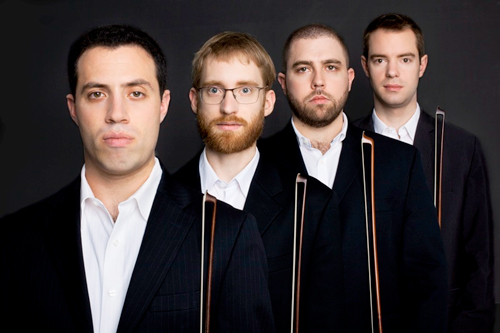by Timothy Robson

The JACK Quartet (violinists Christopher Otto and Ari Streisfeld, violist John Pickford Richards, and cellist Kevin McFarland) met when they were students at the Eastman School of Music. They showed an unmistakably youthful vitality combined with astonishing virtuosity throughout their program, drawing rapt attention and an enthusiastic response from the audience.
The concert opened with arrangements by Ari Streisfeld of three short works by 14th-century French poet and composer Guillaume de Machaut. The quartet morphed their sound into that of a refined viol consort, playing without vibrato, in passages of strange beauty, evoking the dawn of European civilization emerging from the Dark Ages. Complex counterpoint combined with very modern playing techniques to create the effect of something simultaneously very old and very new.
These arrangements were paired with John Zorn’s 2014 The Remedy of Fortune, which was inspired by Machaut’s poem of the same name. It was a study in textural contrasts: cloudy passages, swirls, plucks, and trills, integrated with ethereal passages that sounded as if they had been composed by Machaut — but were not. The sonorities were sometimes sustained, then suddenly aggressive and rhythmic, without a clearly defined pulse. At one point the violin played a psychotically ecstatic cadenza. Silence played a role as well; several “grand pauses” incidentally allowed for page turns. A quiet passage that seemed inconclusively final was followed by a pause. Was this the end of the piece? No, there was one more short, quiet phrase, before the quartet lowered their instruments, signaling the end.

Tuning is a major factor in Celare. Long, sustained notes among the instruments gradually move in and out of intonation so that it is possible to hear the harmonic frequency “beats” as the notes become more or less “in tune.” (In a piece in which intonation is a compositional device, not just a nicety of performance, the terms “in tune” and “out of tune” are meaningless.) Silence is important in this piece. Its relatively few notes are followed by silence or sometimes more “fingered but not bowed” passages — this time, very high-pitched, unheard notes. Celare was an amazing compositional and performance achievement. The JACK Quartet’s technical skills to carry it off were astonishing.
Kevin McFarland’s two short transcriptions from Claudio Monteverdi’s 1607 opera L’Orfeo opened the second half, setting up Caroline Shaw’s Ritornello 2.sq.2.j (2014). Influenced by Monteverdi, it’s an evolving work whose material has been used in several of Shaw’s previous instrumental and vocal versions, including one for Roomful of Teeth, of which Shaw is a member. In contrast to the Zorn and Ergün works earlier on the program, Ritornello is marked by identifiable rhythm and pulse, and a refrain in simple harmonies that changes over time, continually varied and interspersed with other musical materials. An arresting feature is a passage in which chords magically transform from one to another by means of highly controlled, slow glissandi.
Cenk Ergün’s Sonare (“to sound”) closed the concert. It was a highly technical, seemingly impossible tour de force. With a constant pulse, an endless series of extremely fast, repeated notes are played simultaneously, all in the same range, with isolated accents and complex overlapping. It’s as if the quartet were playing the opening phrases of Rimsky-Korsakov’s Flight of the Bumblebee at top speed, but every player in a different key and at slightly different tempos.
The sensation was of a buzzing cloud, a study in density of texture and rhythm with implied harmonics, if not tonality. The dynamic is generally loud, but at one point a major diminuendo occurs, while the pulse goes on. With very few opportunities for quartet members to rest even momentarily, the stamina required for Sonare is almost unbelievable. The JACK gave a marathon performance. At the work’s conclusion, the diverse audience greeted the musicians with well-deserved shouts and applause.
Published on ClevelandClassical.com March 7, 2016.
Click here for a printable copy of this article


